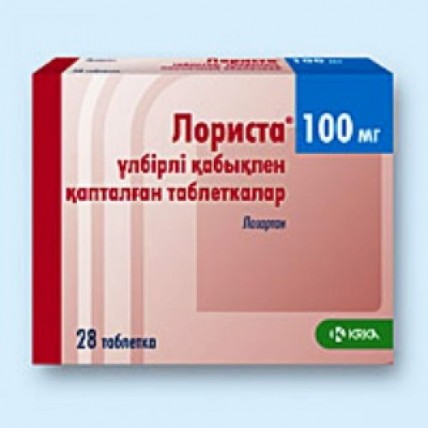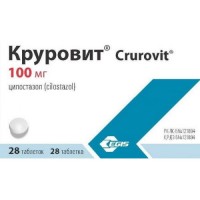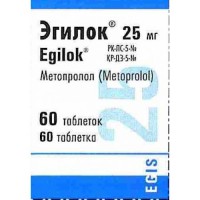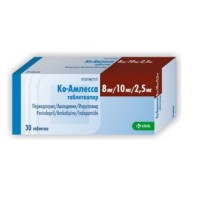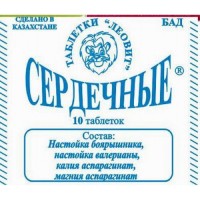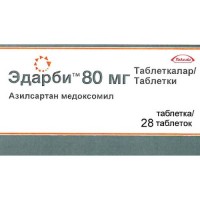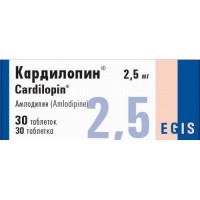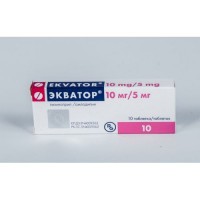Lorista® 28's 100 mg film-coated tablets
- $24.10
The instruction for medical use
of LORISTA® medicine
the Trade name
of Lorista®
the International unlicensed
name Lozartan Lekarstvennaya
the Tablet form, film coated 25 mg, 50 mg and 100 mg
Structure
One tablet contains
active agent - a lozartan of potassium of 25 mg, 50 mg and 100 mg,
excipients: tsellaktoza, starch prezhelatinizirovanny, starch corn, cellulose microcrystalline, silicon dioxide colloidal anhydrous, magnesium stearate
structure of a cover: a gipromelloza, talc, propylene glycol, the titan dioxide (E171) (for dosages of 25 mg, 50 mg, 100 mg), quinolinic yellow (E104) (for a dosage of 25 mg)
the Description
of the Tablet of an oval form, with slightly biconvex surface, film coated yellow color, with risky on one party (for a dosage of 25 mg).
Tablets of round shape, with slightly biconvex surface, film coated white color, with risky on one party and a facet (for a dosage of 50 mg).
Tablets of an oval form, with slightly biconvex surface, film coated white color (for a dosage of 100 mg)
Pharmacotherapeutic group
the Drugs influencing a system renin-angiotensin. Angiotensin II antagonists. Lozartan.
The ATX C09CA01 code
the Pharmacological
Pharmacokinetics Absorption Later properties of intake lozartan is well soaked up from digestive tract, is exposed to considerable metabolism at the first passing through a liver, forming an active metabolite - carboxyl acid and other inactive metabolites. The system bioavailability of a lozartan is about 33%. Average peak concentration of a lozartan is reached within 1 hour, and its active metabolite - within 3-4 hours.
Distribution
Lozartan and his active metabolite more than for 99% contact proteins of plasma, mainly, with albumine. The volume of distribution of a lozartan is equal to 34 liters.
Biotransformation
About 14% of the lozartan entered orally is converted into its active metabolite.
Removal
Plasma clearance of a lozartan and its active metabolite makes about 600 ml/min. and 50 ml/min., respectively. The renal clearance of a lozartan and its active metabolite is about 74 ml/min. and 26 ml/min., respectively. At oral administration of a lozartan about 4% of a dose are removed with urine in an invariable look, and about 6% - in the form of an active metabolite. Pharmacokinetics of a lozartan and its active metabolite linear at oral administration of a lozartan of potassium in doses up to 200 mg.
After intake of concentration of a lozartan and its active metabolite in blood plasma poliexponentsialno decrease, final elimination half-life makes about 2 hours and 6-9 hours, respectively. At reception of a dose of 100 mg once a day lozartan, its active metabolite do not accumulate in plasma in large numbers.
Lozartan and his metabolites are removed with bile and urine: about 35% and 43% are respectively removed with urine, and about 58% and 50% are respectively removed by excrements.
Pharmacokinetics at separate groups of patients
At elderly patients with arterial hypertension of concentration of a lozartan and its active metabolite in blood plasma significantly do not differ from found in young patients with arterial hypertension.
At patients with female arterial hypertension the level of a lozartan in blood plasma is twice higher, than at patients with arterial hypertension is a male while levels of an active metabolite in blood plasma do not differ at men and women.
Patients with slight and moderate alcoholic cirrhosis, in blood plasma after oral administration had levels of a lozartan and its active metabolite respectively in 5 and 1.7 times, respectively above, than at young patients is a male.
Patients with clearance of creatinine have higher than 10 ml/minutes, plasma concentration of a lozartan did not change. In comparison with patients with normal function of kidneys, at the patients who are on a hemodialysis, AUC (the area under a curve concentration time) for a lozartan is approximately twice higher.
At patients with a renal failure or at the patients who are on a hemodialysis, plasma concentration of an active metabolite did not change.
lozartan, an active metabolite cannot be removed by means of a hemodialysis.
The pharmacodynamics
of Lorista® - antihypertensive drug, is a peroral selection antagonist of receptors of angiotensin II (AT1 type). Angiotensin II is active hormone renin-angiotenzinovoy of a system and one of the most important factors of a pathophysiology of arterial hypertension. Angiotensin II contacts the AT1-receptors found in various fabrics (for example, smooth muscle fabric of vessels, adrenal glands, kidneys and heart), and causes a number of important biological effects, including vasoconstriction and release of Aldosteronum. Angiotensin II also stimulates proliferation of smooth muscle cells.
Lozartan and him pharmacological the active metabolite of E3174 is blocked by all physiological effects of angiotensin II regardless of its source and a way of biosynthesis.
Лориста® selectively blocks receptors of AT1 and does not block the receptors of other hormones or ion channels responding to regulation of activity of a cardiovascular system. Moreover, lozartan does not suppress activity of angiotensin-converting enzyme (kinases of II), enzyme which participates in bradykinin splitting.
Single dose of a dose of a lozartan by patients with easy and average degree of arterial hypertension shows significant decrease in systolic and diastolic arterial blood pressure. Its maximum effect develops in 6 hours after reception, therapeutic action remains 24 hours therefore it is enough to be accepted once a day. The antihypertensive effect develops within the first week of therapy, and then accrues gradually and is stabilized in 3-6 weeks
the Drug Lorista® is equally effective at men and women and also at elderly (≥ 65 years) and younger patients (≤ 65 years).
The termination of reception of a lozartan at patients with arterial hypertension does not lead to sharp increase in arterial blood pressure. Despite the profound lowering of arterial pressure, lozartan does not make any clinically significant impacts on heart rate.
Indications
- treatment of essential arterial hypertension at adults
- treatment of a disease of kidneys at adult patients with arterial hypertension
and diabetes 2 types with a proteinuria ≥ 0.5 g/days as a part
of antihypertensive treatment
- treatment of chronic heart failure at adult patients
(fraction of emission of a left ventricle of ≤40%, clinically stable
state) when use of inhibitors
of angiotensin-converting enzyme is considered impossible because of intolerance, especially
at development of cough or when their appointment is contraindicated
- reduction of risk of development of a stroke in adult patients with the arterial
hypertension and a hypertrophy of a left ventricle confirmed to the ECG
the Route of administration and doses
with the Adult
Inside irrespective of meal. Swallow of a tablet, without chewing, washing down with a glass of water. Frequency rate of reception – 1 time a day.
Arterial hypertension
For most of patients an initial and maintenance dose makes 50 mg once a day. The maximum antihypertensive effect is reached within from three to six weeks after the beginning of therapy.
Increase in a dose up to 100 mg can be required by some patients (morning) once a day.
Arterial hypertension at patients with diabetes of the II type with a proteinuria ≥ 0.5 g/day
the Usual initial dose makes 50 mg once a day. The dosage can be increased up to 100 mg on the basis of results of arterial blood pressure in a month after an initiation of treatment once a day. Lozartan it is possible to accept along with other antihypertensive drugs (for example, diuretics, blockers of calcium channels, alpha or beta blockers and drugs of the central action) also, as well as with insulin and other widely used hypoglycemic means (for example, sulphonylurea, glitazon, inhibitor glucosidase).
Heart failure
the Initial dose of the drug Lorista® at patients with heart failure makes 12.5 mg a day in one step. To reach a maintenance dose in 50 mg a day which is usually well transferred by patients the dose of drug needs to be increased gradually by 12.5 mg, with intervals of one week (i.e., 12.5 mg a day, 25 mg a day, 50 mg a day, 100 mg a day, to the maximum dose of 150 mg once a day).
Patients with heart failure whose condition was stabilized at APF inhibitor use should not be transferred to treatment lozartany.
Reduction of risk of development of a stroke in adult patients with the arterial hypertension and a hypertrophy of a left ventricle confirmed to the ECG.
The usual initial dose makes 50 mg of a lozartan once a day. The low dose of a hydrochlorothiazide can be added and/or it is necessary to increase a dose to 100 mg a day on the basis of results of arterial blood pressure.
Side effects
Often (≥ 1/100 to & lt, 1/10):
- dizziness, vertigo
- an asthenia, fatigue
- hypotension, including orthostatic hypotension
- anemia
- a renal failure, impaired renal function
Infrequently (≥ 1/1, 000 to & lt, 1/100):
- a headache, drowsiness, sleep disorders
- a cardiopalmus, stenocardia
- symptomatic hypotension (especially patients with exhaustion of intravascular volume have, for example, patients with heavy heart failure or at treatment by high doses of diuretics), the orthostatic effects connected with a dose, rash
- an abdominal pain, constipations, diarrhea, nausea, vomiting
- short wind, cough, congestion of a nose, pharyngitis, diseases of bosoms,
upper respiratory tract infections
- dispnoe
- urticaria, an itching, rash
- a hyperpotassemia
- increase in the ALT level (usually takes place after drug withdrawal), increase in level of urea in blood, creatinine and potassium in blood plasma
- a hypoglycemia
Seldom (≥ 1/10,000 to & lt, 1/1000):
- paresthesia
- a faint, an atrial fibrillation, a stroke
It is unknown (frequency cannot be estimated on the basis of the available data):
- anemia
- a faint, a cardiopalmus
- orthostatic hypotension
- diarrhea
- a back pain
- infections of urinary tract
- symptoms
, the Side reactions similar to flu registered during the post-marketing period
Frequency cannot be estimated:
- anemia, thrombocytopenia
- a ring in ears
- migraine
- cough
- diarrhea, pancreatitis
- concern
- abnormal liver functions
- urticaria, an itching, rash, photosensitivity
- myalgia, an arthralgia, a rhabdomyolysis
- erectile dysfunction / impotence
- a depression
- a hyponatremia
- changes of function of kidneys, including a renal failure, these changes of function of kidneys can be reversible after the therapy termination
Seldom (≥ 1/10,000 to & lt, 1/1, 000):
- anaphylactic reactions, a Quincke's edema, including edema of laryngeal and glottis causing disturbance of passability of airways and/or edema of face, lips, drinks and/or language at some of these patients a Quincke's edema was registered in connection with intake of other drugs, including APF inhibitors, a vasculitis, including Shenleyna-Genokh's purpura
-
Contraindication hepatitis
- hypersensitivity to active agent or to any
component of drug
- a heavy liver failure
- combined use with aliskireny at patients with diabetes
- pregnancy and the period of a lactation
- children's and teenage age up to 18 years
Medicinal interactions
Other antigipertenzionny drugs can strengthen hypotensive action of a lozartan. Simultaneous use of other drugs which can induce developing of arterial hypotension, as side reaction (such as tricyclic antidepressants, antipsychotic means, Baclofenum, amifostin) can increase risk of developing of hypotension.
Lozartan is mainly metabolized by P450 (CYP) 2C9 cytochrome in active carboxy - an acid metabolite. It is revealed that flukonazol (CYP2C9 inhibitor) is reduced by impact on an active metabolite approximately on 50%. It is also established that simultaneous treatment lozartany and rifampicin (inductor of metabolism of enzymes) gives 40% reduction of plasma concentration of an active metabolite. The clinical importance of this effect is unknown. No difference in influence at joint treatment with fluvastiny (weak CYP2C9 inhibitor) is revealed.
As well as at use of other medicines which block angiotensin II or its effect, simultaneous use of other drugs which contain potassium (for example, kaliysberegayushchy diuretics: amiloride, Triamterenum, Spironolactonum), or can increase potassium level (for example, heparin), can lead the potassium additives or substitutes of salt containing potassium to increase in level of potassium in blood plasma. Joint treatment is not desirable.
Reversible increases in concentration of lithium in blood plasma and toxicity were noted during the accompanying intake of lithium with APF inhibitors, and seldom or never - with antagonists of a receptor of angiotensin II. At combined use of lithium and a lozartan it is necessary to be careful. If such combination is necessary, during the accompanying use it is recommended to control lithium level in blood plasma.
At simultaneous use of antagonists of angiotensin II with non-steroidal anti-inflammatory drugs (i.e. reduction of antihypertensive effect can arise selection TsOG-2 inhibitors, acetylsalicylic acid in anti-inflammatory doses, and non-selective non-steroidal anti-inflammatory drugs). Combined use of antagonists of angiotensin II or diuretics and non-steroidal anti-inflammatory drugs can result in the increased risk of a renal failure, including a possible acute renal failure and also to increase in level of potassium in blood plasma, especially at patients with weak function of kidneys. The combination has to be applied with care, especially at elderly patients. Patients have to accept enough liquid, and it is necessary to control carefully function of kidneys after the beginning of joint therapy and also periodically subsequently.
It is necessary to limit double blockade (for example, prescription of APF inhibitor with the antagonist of receptors of angiotensin II), individually considering each situation, with careful monitoring of function of kidneys. Some researches showed that at patients with the diagnosed atherosclerotic disease, heart failure or diabetes with damage of target organs, double blockade renin-angiotensin-aldosteronovoy of a system is associated with the increased frequency of developing of arterial hypotension, faint, a hyperpotassemia and renal failure (including an acute renal failure), when comparing with use of one drug influencing renin-angiotensin-aldosteronovuyu a system.
The special
instructions Hypersensitivity to Patients with angioedemy (edema of face, lips, throats and/or language) it is necessary to be in the anamnesis under careful observation of the doctor.
Arterial hypotension and an electrolytic/liquid imbalance
Symptomatic hypotension, especially after the first dose, can arise at patients with the exhausted volume of liquid and/or the deficiency of sodium caused by use of strong diuretics, dietary restriction of consumption of salt, diarrhea or vomiting. Such states demand correction before an initiation of treatment lozartany or it is necessary to apply lower initial doses.
The electrolytic imbalance
the Electrolytic imbalance is often observed at patients with impaired renal function (with diabetes or without it) that it is necessary to take into account. Patients with diabetes have 2 types with a nephropathy, the frequency of emergence of a hyperpotassemia in group of the patients receiving lozartan was higher, in comparison with group, than the receiving placebos. Therefore it is regularly necessary to control potassium concentration in blood plasma and indicators of clearance of creatinine, especially at patients with heart failure and clearance of creatinine of 30-50 ml/min. Simultaneous use of the kaliysberegayushchy diuretics, potassium additives and substitutes of salt containing potassium with lozartany is not recommended.
A liver failure
based on the pharmacokinetic data indicating significant increase in concentration of a lozartan in blood plasma at patients with cirrhosis at patients with a liver failure in the anamnesis, it is necessary to consider use of lower doses. There is no experience of therapeutic use of a lozartan for patients with a heavy liver failure. Therefore use of a lozartan for patients with a heavy liver failure is contraindicated.
A renal failure
as a result of inhibition renin-angiotensin-aldosteronovoy of a system changes of function of kidneys were observed, including a renal failure (especially, patients with dependence have functions of kidneys from renin-angiotensin-aldosteronovoy of a system, such as patients with heavy heart failure or with already existing renal failures).
As well as at use of other medicines influencing renin-angiotensin-aldosteronovuyu a system, increases in level of urea in blood and creatinine in blood plasma at patients with a bilateral stenosis of renal arteries or a stenosis of an artery of the only kidney were observed, these changes in function of kidneys can be reversible after the therapy termination. Lozartan it is necessary to apply with care at patients with a bilateral stenosis of renal arteries or a stenosis of an artery of the only kidney.
Transplantation of a kidney
Experience of use of drug for the patients who transferred transplantation of a kidney no.
Primary hyper aldosteronism
At patients with primary aldosteronism, as a rule, is not observed effect at use of the antihypertensive drugs operating by oppression system renin-angiotenzinovoy. Therefore use of a lozartan is not recommended for this group of patients.
Coronary heart disease and cerebrovascular diseases:
As well as at use of other antihypertensive drugs, the excess lowering of arterial pressure at patients with coronary heart disease and a cerebrovascular disease, can lead to development of a myocardial infarction or stroke.
Heart failure
As well as at use of other drugs influencing renin-angiotensin-aldosteronovuyu a system for patients with heart failure with impaired renal function or without it, exists risk of developing heavy arterial hypotension and (often acute) renal failure.
Sufficient experience of therapeutic use of a lozartan for patients with heart failure and the accompanying heavy renal failure, at patients with heavy heart failure (NYHA class IV) and also at patients with heart failure and symptoms, life-threatening, arrhythmias, no. Therefore, lozartan it is necessary to apply with care at these groups of patients. The combination of a lozartan with beta-blockers should be applied with care.
The stenosis of aortal and mitral valves, a subaortic hypertrophic stenosis
As well as at use of other vazodilatator, with extra care appoint to patients with a stenosis of the aortal or mitral valve or a subaortic hypertrophic stenosis.
As it was noted other preventions and precautionary measures, APF inhibitors, lozartan and other angiotenzinovyeantagonist, are less effective in a lowering of arterial pressure at people of negroid race, than at others, perhaps, it is connected with prevalence of lowrenine states at this hypertensive population.
Information on
Lorista® excipients contains lactose. Patients with rare hereditary forms of intolerance of a galactose, deficiency of Lappa lactase or disturbance of absorption of glucose galactose should not take this drug.
The feature of influence of medicine on ability to run the vehicle or potentially dangerous mechanisms
When driving or using potentially dangerous mechanisms should consider that at acceptance of antihypertensive drugs there can sometimes be dizziness or drowsiness, especially in an initiation of treatment or at increase in a dosage.
Overdose
Symptoms: arterial hypotension and tachycardia, because of parasympathetic (vagal) stimulation can develop bradycardia.
Treatment: actions depend on time of administration of drug, a type and gravity of symptoms. The paramount value should be given to stabilization of the blood circulatory system. Prescribing of activated carbon. Control of vital important signs.
The hemodialysis is inefficient as lozartan, its active metabolite are not removed at a hemodialysis.
The form of release and packing
On 14 tablets place in blister strip packaging from a film of polyvinylchloride/polyvinyldichloride and aluminum foil.
On 1 or 2 blister strip packagings together with the instruction for medical use in the state and Russian languages place in a pack from cardboard
Storage conditions
to Store at a temperature not over 30 ºС.
To store out of children's reach!
Not to apply a period of storage of 5 years after an expiration date.
Prescription status
According to the prescription
the Producer
of KRK, of. The place is new, Slovenia
Shmaryeshka 6, 8501 the place, Slovenia
the Owner of a registration udostvoreniye
of KRK, of Is new. The place, Slovenia
the Address of the organization accepting in the territory of the Republic of Kazakhstan claims from consumers on quality of products (goods)
of KRKA Kazakhstan LLP is new, RK, 050059, Almaty, Al-Farabi Ave. 19, body 1b, the 2nd floor, the 207th office
ph.: +7 (727) 311 08 09
fax: +7 (727) 311 08 12
info.kz@krka.biz
to Develop
of LORISTA® medicine
the Trade name
of Lorista®
the International unlicensed
name Lozartan Lekarstvennaya
the Tablet form, film coated 25 mg, 50 mg and 100 mg
Structure
One tablet contains
active agent - a lozartan of potassium of 25 mg, 50 mg and 100 mg,
excipients: tsellaktoza, starch prezhelatinizirovanny, starch corn, cellulose microcrystalline, silicon dioxide colloidal anhydrous, magnesium stearate
structure of a cover: a gipromelloza, talc, propylene glycol, the titan dioxide (E171) (for dosages of 25 mg, 50 mg, 100 mg), quinolinic yellow (E104) (for a dosage of 25 mg)
the Description
of the Tablet of an oval form, with slightly biconvex surface, film coated yellow color, with risky on one party (for a dosage of 25 mg).
Tablets of round shape, with slightly biconvex surface, film coated white color, with risky on one party and a facet (for a dosage of 50 mg).
Tablets of an oval form, with slightly biconvex surface, film coated white color (for a dosage of 100 mg)
Pharmacotherapeutic group
the Drugs influencing a system renin-angiotensin. Angiotensin II antagonists. Lozartan.
The ATX C09CA01 code
the Pharmacological
Pharmacokinetics Absorption Later properties of intake lozartan is well soaked up from digestive tract, is exposed to considerable metabolism at the first passing through a liver, forming an active metabolite - carboxyl acid and other inactive metabolites. The system bioavailability of a lozartan is about 33%. Average peak concentration of a lozartan is reached within 1 hour, and its active metabolite - within 3-4 hours.
Distribution
Lozartan and his active metabolite more than for 99% contact proteins of plasma, mainly, with albumine. The volume of distribution of a lozartan is equal to 34 liters.
Biotransformation
About 14% of the lozartan entered orally is converted into its active metabolite.
Removal
Plasma clearance of a lozartan and its active metabolite makes about 600 ml/min. and 50 ml/min., respectively. The renal clearance of a lozartan and its active metabolite is about 74 ml/min. and 26 ml/min., respectively. At oral administration of a lozartan about 4% of a dose are removed with urine in an invariable look, and about 6% - in the form of an active metabolite. Pharmacokinetics of a lozartan and its active metabolite linear at oral administration of a lozartan of potassium in doses up to 200 mg.
After intake of concentration of a lozartan and its active metabolite in blood plasma poliexponentsialno decrease, final elimination half-life makes about 2 hours and 6-9 hours, respectively. At reception of a dose of 100 mg once a day lozartan, its active metabolite do not accumulate in plasma in large numbers.
Lozartan and his metabolites are removed with bile and urine: about 35% and 43% are respectively removed with urine, and about 58% and 50% are respectively removed by excrements.
Pharmacokinetics at separate groups of patients
At elderly patients with arterial hypertension of concentration of a lozartan and its active metabolite in blood plasma significantly do not differ from found in young patients with arterial hypertension.
At patients with female arterial hypertension the level of a lozartan in blood plasma is twice higher, than at patients with arterial hypertension is a male while levels of an active metabolite in blood plasma do not differ at men and women.
Patients with slight and moderate alcoholic cirrhosis, in blood plasma after oral administration had levels of a lozartan and its active metabolite respectively in 5 and 1.7 times, respectively above, than at young patients is a male.
Patients with clearance of creatinine have higher than 10 ml/minutes, plasma concentration of a lozartan did not change. In comparison with patients with normal function of kidneys, at the patients who are on a hemodialysis, AUC (the area under a curve concentration time) for a lozartan is approximately twice higher.
At patients with a renal failure or at the patients who are on a hemodialysis, plasma concentration of an active metabolite did not change.
lozartan, an active metabolite cannot be removed by means of a hemodialysis.
The pharmacodynamics
of Lorista® - antihypertensive drug, is a peroral selection antagonist of receptors of angiotensin II (AT1 type). Angiotensin II is active hormone renin-angiotenzinovoy of a system and one of the most important factors of a pathophysiology of arterial hypertension. Angiotensin II contacts the AT1-receptors found in various fabrics (for example, smooth muscle fabric of vessels, adrenal glands, kidneys and heart), and causes a number of important biological effects, including vasoconstriction and release of Aldosteronum. Angiotensin II also stimulates proliferation of smooth muscle cells.
Lozartan and him pharmacological the active metabolite of E3174 is blocked by all physiological effects of angiotensin II regardless of its source and a way of biosynthesis.
Лориста® selectively blocks receptors of AT1 and does not block the receptors of other hormones or ion channels responding to regulation of activity of a cardiovascular system. Moreover, lozartan does not suppress activity of angiotensin-converting enzyme (kinases of II), enzyme which participates in bradykinin splitting.
Single dose of a dose of a lozartan by patients with easy and average degree of arterial hypertension shows significant decrease in systolic and diastolic arterial blood pressure. Its maximum effect develops in 6 hours after reception, therapeutic action remains 24 hours therefore it is enough to be accepted once a day. The antihypertensive effect develops within the first week of therapy, and then accrues gradually and is stabilized in 3-6 weeks
the Drug Lorista® is equally effective at men and women and also at elderly (≥ 65 years) and younger patients (≤ 65 years).
The termination of reception of a lozartan at patients with arterial hypertension does not lead to sharp increase in arterial blood pressure. Despite the profound lowering of arterial pressure, lozartan does not make any clinically significant impacts on heart rate.
Indications
- treatment of essential arterial hypertension at adults
- treatment of a disease of kidneys at adult patients with arterial hypertension
and diabetes 2 types with a proteinuria ≥ 0.5 g/days as a part
of antihypertensive treatment
- treatment of chronic heart failure at adult patients
(fraction of emission of a left ventricle of ≤40%, clinically stable
state) when use of inhibitors
of angiotensin-converting enzyme is considered impossible because of intolerance, especially
at development of cough or when their appointment is contraindicated
- reduction of risk of development of a stroke in adult patients with the arterial
hypertension and a hypertrophy of a left ventricle confirmed to the ECG
the Route of administration and doses
with the Adult
Inside irrespective of meal. Swallow of a tablet, without chewing, washing down with a glass of water. Frequency rate of reception – 1 time a day.
Arterial hypertension
For most of patients an initial and maintenance dose makes 50 mg once a day. The maximum antihypertensive effect is reached within from three to six weeks after the beginning of therapy.
Increase in a dose up to 100 mg can be required by some patients (morning) once a day.
Arterial hypertension at patients with diabetes of the II type with a proteinuria ≥ 0.5 g/day
the Usual initial dose makes 50 mg once a day. The dosage can be increased up to 100 mg on the basis of results of arterial blood pressure in a month after an initiation of treatment once a day. Lozartan it is possible to accept along with other antihypertensive drugs (for example, diuretics, blockers of calcium channels, alpha or beta blockers and drugs of the central action) also, as well as with insulin and other widely used hypoglycemic means (for example, sulphonylurea, glitazon, inhibitor glucosidase).
Heart failure
the Initial dose of the drug Lorista® at patients with heart failure makes 12.5 mg a day in one step. To reach a maintenance dose in 50 mg a day which is usually well transferred by patients the dose of drug needs to be increased gradually by 12.5 mg, with intervals of one week (i.e., 12.5 mg a day, 25 mg a day, 50 mg a day, 100 mg a day, to the maximum dose of 150 mg once a day).
Patients with heart failure whose condition was stabilized at APF inhibitor use should not be transferred to treatment lozartany.
Reduction of risk of development of a stroke in adult patients with the arterial hypertension and a hypertrophy of a left ventricle confirmed to the ECG.
The usual initial dose makes 50 mg of a lozartan once a day. The low dose of a hydrochlorothiazide can be added and/or it is necessary to increase a dose to 100 mg a day on the basis of results of arterial blood pressure.
Side effects
Often (≥ 1/100 to & lt, 1/10):
- dizziness, vertigo
- an asthenia, fatigue
- hypotension, including orthostatic hypotension
- anemia
- a renal failure, impaired renal function
Infrequently (≥ 1/1, 000 to & lt, 1/100):
- a headache, drowsiness, sleep disorders
- a cardiopalmus, stenocardia
- symptomatic hypotension (especially patients with exhaustion of intravascular volume have, for example, patients with heavy heart failure or at treatment by high doses of diuretics), the orthostatic effects connected with a dose, rash
- an abdominal pain, constipations, diarrhea, nausea, vomiting
- short wind, cough, congestion of a nose, pharyngitis, diseases of bosoms,
upper respiratory tract infections
- dispnoe
- urticaria, an itching, rash
- a hyperpotassemia
- increase in the ALT level (usually takes place after drug withdrawal), increase in level of urea in blood, creatinine and potassium in blood plasma
- a hypoglycemia
Seldom (≥ 1/10,000 to & lt, 1/1000):
- paresthesia
- a faint, an atrial fibrillation, a stroke
It is unknown (frequency cannot be estimated on the basis of the available data):
- anemia
- a faint, a cardiopalmus
- orthostatic hypotension
- diarrhea
- a back pain
- infections of urinary tract
- symptoms
, the Side reactions similar to flu registered during the post-marketing period
Frequency cannot be estimated:
- anemia, thrombocytopenia
- a ring in ears
- migraine
- cough
- diarrhea, pancreatitis
- concern
- abnormal liver functions
- urticaria, an itching, rash, photosensitivity
- myalgia, an arthralgia, a rhabdomyolysis
- erectile dysfunction / impotence
- a depression
- a hyponatremia
- changes of function of kidneys, including a renal failure, these changes of function of kidneys can be reversible after the therapy termination
Seldom (≥ 1/10,000 to & lt, 1/1, 000):
- anaphylactic reactions, a Quincke's edema, including edema of laryngeal and glottis causing disturbance of passability of airways and/or edema of face, lips, drinks and/or language at some of these patients a Quincke's edema was registered in connection with intake of other drugs, including APF inhibitors, a vasculitis, including Shenleyna-Genokh's purpura
-
Contraindication hepatitis
- hypersensitivity to active agent or to any
component of drug
- a heavy liver failure
- combined use with aliskireny at patients with diabetes
- pregnancy and the period of a lactation
- children's and teenage age up to 18 years
Medicinal interactions
Other antigipertenzionny drugs can strengthen hypotensive action of a lozartan. Simultaneous use of other drugs which can induce developing of arterial hypotension, as side reaction (such as tricyclic antidepressants, antipsychotic means, Baclofenum, amifostin) can increase risk of developing of hypotension.
Lozartan is mainly metabolized by P450 (CYP) 2C9 cytochrome in active carboxy - an acid metabolite. It is revealed that flukonazol (CYP2C9 inhibitor) is reduced by impact on an active metabolite approximately on 50%. It is also established that simultaneous treatment lozartany and rifampicin (inductor of metabolism of enzymes) gives 40% reduction of plasma concentration of an active metabolite. The clinical importance of this effect is unknown. No difference in influence at joint treatment with fluvastiny (weak CYP2C9 inhibitor) is revealed.
As well as at use of other medicines which block angiotensin II or its effect, simultaneous use of other drugs which contain potassium (for example, kaliysberegayushchy diuretics: amiloride, Triamterenum, Spironolactonum), or can increase potassium level (for example, heparin), can lead the potassium additives or substitutes of salt containing potassium to increase in level of potassium in blood plasma. Joint treatment is not desirable.
Reversible increases in concentration of lithium in blood plasma and toxicity were noted during the accompanying intake of lithium with APF inhibitors, and seldom or never - with antagonists of a receptor of angiotensin II. At combined use of lithium and a lozartan it is necessary to be careful. If such combination is necessary, during the accompanying use it is recommended to control lithium level in blood plasma.
At simultaneous use of antagonists of angiotensin II with non-steroidal anti-inflammatory drugs (i.e. reduction of antihypertensive effect can arise selection TsOG-2 inhibitors, acetylsalicylic acid in anti-inflammatory doses, and non-selective non-steroidal anti-inflammatory drugs). Combined use of antagonists of angiotensin II or diuretics and non-steroidal anti-inflammatory drugs can result in the increased risk of a renal failure, including a possible acute renal failure and also to increase in level of potassium in blood plasma, especially at patients with weak function of kidneys. The combination has to be applied with care, especially at elderly patients. Patients have to accept enough liquid, and it is necessary to control carefully function of kidneys after the beginning of joint therapy and also periodically subsequently.
It is necessary to limit double blockade (for example, prescription of APF inhibitor with the antagonist of receptors of angiotensin II), individually considering each situation, with careful monitoring of function of kidneys. Some researches showed that at patients with the diagnosed atherosclerotic disease, heart failure or diabetes with damage of target organs, double blockade renin-angiotensin-aldosteronovoy of a system is associated with the increased frequency of developing of arterial hypotension, faint, a hyperpotassemia and renal failure (including an acute renal failure), when comparing with use of one drug influencing renin-angiotensin-aldosteronovuyu a system.
The special
instructions Hypersensitivity to Patients with angioedemy (edema of face, lips, throats and/or language) it is necessary to be in the anamnesis under careful observation of the doctor.
Arterial hypotension and an electrolytic/liquid imbalance
Symptomatic hypotension, especially after the first dose, can arise at patients with the exhausted volume of liquid and/or the deficiency of sodium caused by use of strong diuretics, dietary restriction of consumption of salt, diarrhea or vomiting. Such states demand correction before an initiation of treatment lozartany or it is necessary to apply lower initial doses.
The electrolytic imbalance
the Electrolytic imbalance is often observed at patients with impaired renal function (with diabetes or without it) that it is necessary to take into account. Patients with diabetes have 2 types with a nephropathy, the frequency of emergence of a hyperpotassemia in group of the patients receiving lozartan was higher, in comparison with group, than the receiving placebos. Therefore it is regularly necessary to control potassium concentration in blood plasma and indicators of clearance of creatinine, especially at patients with heart failure and clearance of creatinine of 30-50 ml/min. Simultaneous use of the kaliysberegayushchy diuretics, potassium additives and substitutes of salt containing potassium with lozartany is not recommended.
A liver failure
based on the pharmacokinetic data indicating significant increase in concentration of a lozartan in blood plasma at patients with cirrhosis at patients with a liver failure in the anamnesis, it is necessary to consider use of lower doses. There is no experience of therapeutic use of a lozartan for patients with a heavy liver failure. Therefore use of a lozartan for patients with a heavy liver failure is contraindicated.
A renal failure
as a result of inhibition renin-angiotensin-aldosteronovoy of a system changes of function of kidneys were observed, including a renal failure (especially, patients with dependence have functions of kidneys from renin-angiotensin-aldosteronovoy of a system, such as patients with heavy heart failure or with already existing renal failures).
As well as at use of other medicines influencing renin-angiotensin-aldosteronovuyu a system, increases in level of urea in blood and creatinine in blood plasma at patients with a bilateral stenosis of renal arteries or a stenosis of an artery of the only kidney were observed, these changes in function of kidneys can be reversible after the therapy termination. Lozartan it is necessary to apply with care at patients with a bilateral stenosis of renal arteries or a stenosis of an artery of the only kidney.
Transplantation of a kidney
Experience of use of drug for the patients who transferred transplantation of a kidney no.
Primary hyper aldosteronism
At patients with primary aldosteronism, as a rule, is not observed effect at use of the antihypertensive drugs operating by oppression system renin-angiotenzinovoy. Therefore use of a lozartan is not recommended for this group of patients.
Coronary heart disease and cerebrovascular diseases:
As well as at use of other antihypertensive drugs, the excess lowering of arterial pressure at patients with coronary heart disease and a cerebrovascular disease, can lead to development of a myocardial infarction or stroke.
Heart failure
As well as at use of other drugs influencing renin-angiotensin-aldosteronovuyu a system for patients with heart failure with impaired renal function or without it, exists risk of developing heavy arterial hypotension and (often acute) renal failure.
Sufficient experience of therapeutic use of a lozartan for patients with heart failure and the accompanying heavy renal failure, at patients with heavy heart failure (NYHA class IV) and also at patients with heart failure and symptoms, life-threatening, arrhythmias, no. Therefore, lozartan it is necessary to apply with care at these groups of patients. The combination of a lozartan with beta-blockers should be applied with care.
The stenosis of aortal and mitral valves, a subaortic hypertrophic stenosis
As well as at use of other vazodilatator, with extra care appoint to patients with a stenosis of the aortal or mitral valve or a subaortic hypertrophic stenosis.
As it was noted other preventions and precautionary measures, APF inhibitors, lozartan and other angiotenzinovyeantagonist, are less effective in a lowering of arterial pressure at people of negroid race, than at others, perhaps, it is connected with prevalence of lowrenine states at this hypertensive population.
Information on
Lorista® excipients contains lactose. Patients with rare hereditary forms of intolerance of a galactose, deficiency of Lappa lactase or disturbance of absorption of glucose galactose should not take this drug.
The feature of influence of medicine on ability to run the vehicle or potentially dangerous mechanisms
When driving or using potentially dangerous mechanisms should consider that at acceptance of antihypertensive drugs there can sometimes be dizziness or drowsiness, especially in an initiation of treatment or at increase in a dosage.
Overdose
Symptoms: arterial hypotension and tachycardia, because of parasympathetic (vagal) stimulation can develop bradycardia.
Treatment: actions depend on time of administration of drug, a type and gravity of symptoms. The paramount value should be given to stabilization of the blood circulatory system. Prescribing of activated carbon. Control of vital important signs.
The hemodialysis is inefficient as lozartan, its active metabolite are not removed at a hemodialysis.
The form of release and packing
On 14 tablets place in blister strip packaging from a film of polyvinylchloride/polyvinyldichloride and aluminum foil.
On 1 or 2 blister strip packagings together with the instruction for medical use in the state and Russian languages place in a pack from cardboard
Storage conditions
to Store at a temperature not over 30 ºС.
To store out of children's reach!
Not to apply a period of storage of 5 years after an expiration date.
Prescription status
According to the prescription
the Producer
of KRK, of. The place is new, Slovenia
Shmaryeshka 6, 8501 the place, Slovenia
the Owner of a registration udostvoreniye
of KRK, of Is new. The place, Slovenia
the Address of the organization accepting in the territory of the Republic of Kazakhstan claims from consumers on quality of products (goods)
of KRKA Kazakhstan LLP is new, RK, 050059, Almaty, Al-Farabi Ave. 19, body 1b, the 2nd floor, the 207th office
ph.: +7 (727) 311 08 09
fax: +7 (727) 311 08 12
info.kz@krka.biz
to Develop
